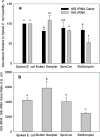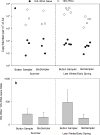Analysis of airborne microbial communities using 16S ribosomal RNA: Potential bias due to air sampling stress
- PMID: 29079080
- PMCID: PMC5805565
- DOI: 10.1016/j.scitotenv.2017.10.154
Analysis of airborne microbial communities using 16S ribosomal RNA: Potential bias due to air sampling stress
Abstract
A limited number of studies have been conducted to analyze ribosomal RNA (rRNA, present in the ribosome) in bioaerosol samples to identify currently or potentially active airborne microbes, although its genomic counterpart, the rRNA gene (on the chromosome) has been frequently targeted for airborne microbial community analysis. A knowledge gap still exists regarding whether the bioaerosol rRNA abundances are affected by the bioaerosol collection process. We investigated the effect of air sampling stress on the measurement and characterization of 16S rRNA for bioaerosols in the laboratory and field experiments using quantitative polymerase chain reaction (qPCR) and high-throughput sequencing techniques. In a laboratory study, known quantities of freshly grown Escherichia coli cells were spiked onto the filter of a Button Aerosol Sampler and into liquids of BioSampler and SpinCon air samplers and then exposed to sampling stress when the samplers were operated for 2h. We found that the recovered cellular 16S rRNA abundance as determined by qPCR was dependent on sampler type. Further, two devices (Button Aerosol Sampler and BioSampler) that exhibited markedly different efficiency in preserving 16S rRNA were employed in an outdoor environment to collect bioaerosols simultaneously on eight days in two different seasons. The abundance of 16S rRNA in the outdoor air sample (1.3×106-4.9×107copies/m3) was about two orders of magnitude higher than that of 16S rRNA gene (6.9×103-1.5×105copies/m3). The 16S rRNA sequences revealed a different bacterial community compared with 16S rRNA gene-based results across all samples, and this difference depended on the sampling device. In addition, a number of bacterial taxa exhibited higher abundance in the 16S rRNA gene sequences than in 16S rRNA sequences, which suggests the potential activities of certain microbes in airborne phase. Overall, this study highlights the importance of sampling device selection when analyzing RNA in bioaerosols.
Keywords: 16S rRNA sequencing; Bioaerosols; Microbial community; Sampling device; Stress; rRNA:rDNA ratio.
Copyright © 2017 Elsevier B.V. All rights reserved.
Figures





Similar articles
-
Applicability of a modified MCE filter method with Button Inhalable Sampler for monitoring personal bioaerosol inhalation exposure.Environ Sci Pollut Res Int. 2013 May;20(5):2963-72. doi: 10.1007/s11356-012-1204-6. Epub 2012 Sep 30. Environ Sci Pollut Res Int. 2013. PMID: 23054771
-
Bioaerosol Sampler Choice Should Consider Efficiency and Ability of Samplers To Cover Microbial Diversity.Appl Environ Microbiol. 2018 Nov 15;84(23):e01589-18. doi: 10.1128/AEM.01589-18. Print 2018 Dec 1. Appl Environ Microbiol. 2018. PMID: 30217848 Free PMC article.
-
Evaluation of bioaerosol samplers for the detection and quantification of influenza virus from artificial aerosols and influenza virus-infected ferrets.Influenza Other Respir Viruses. 2019 Nov;13(6):564-573. doi: 10.1111/irv.12678. Epub 2019 Sep 21. Influenza Other Respir Viruses. 2019. PMID: 31541519 Free PMC article.
-
Airborne bacterial communities of outdoor environments and their associated influencing factors.Environ Int. 2020 Dec;145:106156. doi: 10.1016/j.envint.2020.106156. Epub 2020 Oct 8. Environ Int. 2020. PMID: 33039877 Review.
-
Advancing transcriptomic profiling of airborne bacteria.Appl Environ Microbiol. 2025 May 21;91(5):e0014825. doi: 10.1128/aem.00148-25. Epub 2025 Apr 28. Appl Environ Microbiol. 2025. PMID: 40293243 Free PMC article. Review.
Cited by
-
Bioaerosol Sampling: Classical Approaches, Advances, and Perspectives.Aerosol Sci Technol. 2020;54(5):496-519. doi: 10.1080/02786826.2019.1671950. Epub 2019 Oct 4. Aerosol Sci Technol. 2020. PMID: 35923417 Free PMC article.
-
Advances in single-cell sequencing technology in microbiome research.Genes Dis. 2023 Sep 28;11(4):101129. doi: 10.1016/j.gendis.2023.101129. eCollection 2024 Jul. Genes Dis. 2023. PMID: 38545125 Free PMC article. Review.
-
Characterization and DNA Stable-Isotope Probing of Methanotrophic Bioaerosols.Microbiol Spectr. 2022 Dec 21;10(6):e0342122. doi: 10.1128/spectrum.03421-22. Epub 2022 Nov 21. Microbiol Spectr. 2022. PMID: 36409096 Free PMC article.
-
Canopy Position Has a Stronger Effect than Tree Species Identity on Phyllosphere Bacterial Diversity in a Floodplain Hardwood Forest.Microb Ecol. 2021 Jan;81(1):157-168. doi: 10.1007/s00248-020-01565-y. Epub 2020 Aug 6. Microb Ecol. 2021. PMID: 32761502 Free PMC article.
-
Sampling efficiency and nucleic acid stability during long-term sampling with different bioaerosol samplers.Environ Monit Assess. 2024 May 25;196(6):577. doi: 10.1007/s10661-024-12735-7. Environ Monit Assess. 2024. PMID: 38795190 Free PMC article.
References
-
- Keer JT, Birch L. Molecular methods for the assessment of bacterial viability. J. Microbiol. Methods. 2003;53:175–183. - PubMed
-
- England LS, Holmes SB, Trevors JT. Persistence of viruses and DNA in soil. World Journal of Microbiology & Biotechnology. 1998;14(2):163–169.
MeSH terms
Substances
Grants and funding
LinkOut - more resources
Full Text Sources
Other Literature Sources
Miscellaneous

